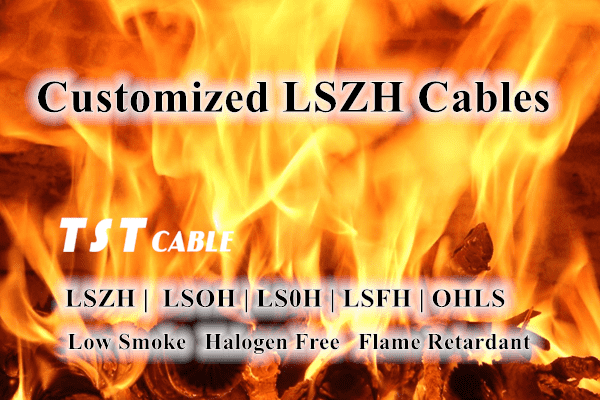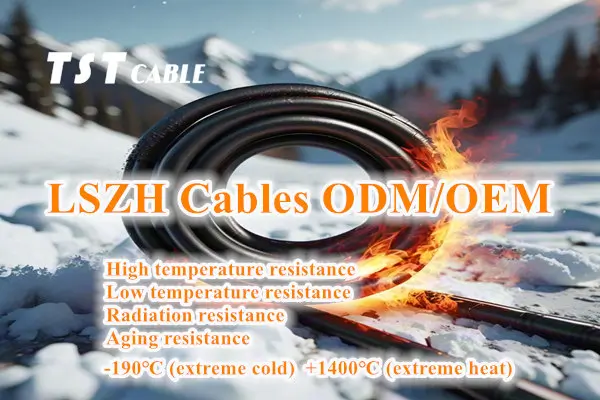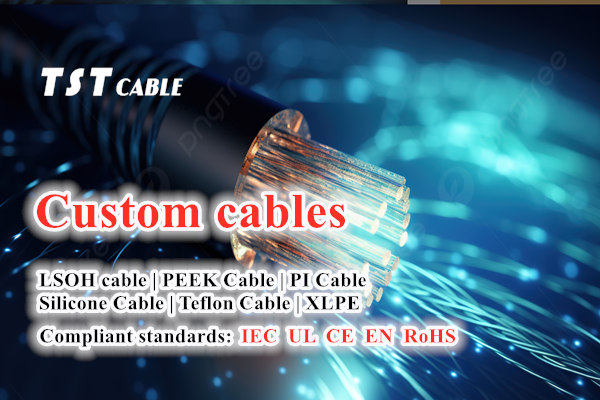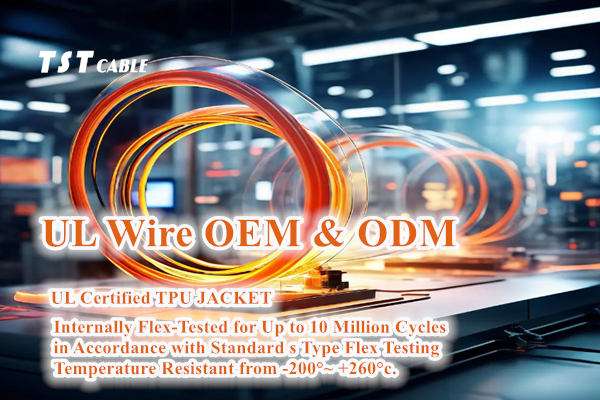What is XLPO cable?

XLPO cable, or cross-linked polyolefin cable, is a special type of insulating material cable in the cable industry, which cross-links polyolefin materials (e.g., ethylene vinyl acetate copolymer EVA) by chemical or physical methods to form a three-dimensional mesh structure, thus significantly improving the thermal stability, mechanical properties and chemical resistance of the cable.
What is XLPE cable?
XLPE cables, or Cross-Linked Polyethylene cables, are centered on the use of Cross-Linked Polyethylene in the insulation layer. The cross-linking process alters the original linear molecular structure of polyethylene by chemically or physically forming a stable three-dimensional mesh between the molecules. This cross-linking process significantly enhances the heat resistance, mechanical strength and chemical stability of the material.
The following is a detailed description of the characteristics of XLPO cable, application and comparison with XLPE cable:
XLPO cable characteristics:
High temperature resistance: XLPO cable can withstand high operating temperatures, usually ranging from -40°C to 150°C, which makes it suitable for some electrical equipment in high temperature environments.
Low smoke and halogen free: XLPO materials are usually designed as low smoke and halogen free types, which means that they produce less smoke when burned and do not contain halogen elements, reducing toxic smoke and corrosive gases in the event of a fire, which facilitates the safe evacuation of people and the protection of equipment.
Flame retardant: XLPO cables have good flame retardant properties that slow down the spread of fire and comply with safety standards in all types of construction, transportation and industrial areas.
Mechanical properties: The cross-linking process enhances the mechanical strength and abrasion resistance of the cable, making it more resistant to bending and stretching, making it suitable for use in complex installation environments.
Chemical resistance: XLPO material has good resistance to many chemicals, suitable for use in chemical, petroleum and other corrosive environments.
XLPO cable application areas:
Electric Vehicle Charging: As mentioned earlier, 2.5mm² XLPO cables are suitable for electric vehicle charging and can effectively cope with the challenges posed by outdoor environments and frequent use.
Automotive interior wiring: Inside automobiles, especially where there are strict requirements for fire protection, low smoke and non-toxicity, such as instrument panel wiring, power system connections, etc.
Rail transportation: electrical systems inside rail vehicles such as subways and trains require cables that are both safe and durable, and XLPO cables are the ideal choice.
Industrial automation: In industrial environments with high temperatures, high humidity and risk of chemical corrosion, XLPO cables provide stable electrical connections.
Building wiring: Especially in public buildings, hospitals, and schools where fire safety is critical, XLPO cables meet high standards with their low-smoke, halogen-free, flame-retardant properties.
What is the difference between XLPO cable and XLPE cable?
XLPO (cross-linked polyolefin) cables and XLPE (cross-linked polyethylene) cables are both insulating materials treated by a cross-linking process designed to improve the heat resistance, mechanical properties, and chemical resistance of the cables, but they differ in terms of cable structure, raw materials, areas of application, and certain performance characteristics:
Differences in cable structure
Typical structure of XLPE cables:
Conductor: usually copper or aluminum, with the appropriate cross-section and type of conductor (solid or stranded) selected according to the needs of the application.
Insulation: Cross-linked polyethylene (XLPE) layer, with excellent resistance to high temperatures, chemical corrosion and electrical insulation, operating temperatures up to 90°C or more.
Sheath: Depending on the application environment, PVC, polyethylene, flame-retardant materials or other specialty materials may be used to provide mechanical protection and environmental protection.
Armor layer (optional): When enhanced mechanical protection is required, a steel tape or steel wire armor layer is added to the sheath to increase the cable’s tensile strength and resistance to rodent bites.
Sheathing (optional): The armor may be covered with an additional sheath to further protect the cable from the external environment.
Typical construction of XLPO cables:
Conductor: Copper or aluminum conductors are also used to meet different voltage levels and current carrying requirements.
Insulation: cross-linked polyolefin (XLPO) layer, this layer of material not only has good electrical insulation properties, but also in the combustion of smoke release less, halogen-free, more environmentally safe.
Sheath: Usually low-smoke halogen-free materials are used to comply with safety and environmental standards, and sometimes specific sheath materials are selected according to the different environments of use.
Special design: According to specific applications, XLPO cables may be designed with enhanced flame retardant layers, oil and chemical resistant layers, etc., in order to adapt to specific working environments.
Different raw material bases
XLPO: Individual polymers or copolymers based primarily on EVA (ethylene vinyl acetate copolymer) or other olefins, such as ethylene, propylene, etc. This material tends to emphasize low-smoke, halogen-free properties and is particularly suitable for locations where safety is critical.
XLPE: The base material is polyethylene (PE), which is chemically or physically cross-linked between its molecules. XLPE has a higher temperature resistance rating and better electrical properties than ordinary PE.
Application Areas
XLPO: Because of its low smoke, no halogen, and good flame retardant properties, it is often used in occasions with high requirements for safety and environmental protection, such as indoor wiring, rail transportation, automobile internal wiring, and public buildings. It is especially suitable for those environments that require minimizing the amount of smoke and toxic gases released during combustion.
XLPE: Widely used in power transmission and distribution systems, including high-voltage and ultra-high-voltage cables, such as power transmission grids, wind farms, solar power stations, submarine cables, etc. XLPE cables are characterized by high heat resistance and high mechanical strength, which makes them suitable for high-voltage and large-capacity power transmission.
Performance Characteristics
Temperature resistance: Although both can withstand high operating temperatures, the upper limit of long-term operating temperature of XLPE cables is generally higher than that of XLPO, which can reach more than 90°C, while the temperature range of XLPO cables is usually between -40°C and 150°C, depending on the design and application requirements.
Mechanical properties: The mechanical strength of XLPE cables is usually higher than that of XLPO, which makes them more suitable to withstand high voltage, large loads and mechanical stress in harsh environments.
Flame retardant and environmentally friendly: XLPO cables are superior in terms of flame retardancy and low smoke and halogen free and comply with more environmentally specific safety standards, whereas XLPE cables are also available in this area in the corresponding grades, but the main advantage lies in their electrical properties and heat resistance.
Cost and availability
Cost: Costs vary due to differences in materials and production processes. Generally, XLPE cables are more widely used in power transmission, where economies of scale may lead to relatively low costs.
Market Acceptance: XLPE cables have a high degree of market acceptance and standardization due to their long term application and maturity in the power industry, whereas XLPO cables have gained favor in specific areas due to their unique advantages.
TST CABLES reminds users that XLPO cables and XLPE cables have their own focus, and the choice should be based on the specific application environment, safety requirements, electrical performance needs and cost budget and other factors, etc. XLPO cables are more inclined to safety, environmental protection, and specific environmental adaptability, while XLPE cables have demonstrated excellent performance and a wide range of applications in the field of power transmission. If you are not sure whether to use XLPO cable or XLPE cable, please feel free to email or call TST CABLES, senior engineers are happy to serve you.
XLPO cable installation and maintenance characteristics:
Flexibility and ease of installation: XLPO cable has better flexibility and bending properties due to its cross-linked molecular structure, which makes it easy to lay in narrow spaces, reducing installation difficulties and time costs. At the same time, its lightweight characteristics make handling and operation more convenient.
Long-life design: The cross-linking process significantly improves the cable’s aging resistance and maintains stable performance for a long time, even in harsh outdoor environments, reducing the frequency of replacement and maintenance, and lowering overall life cycle costs.
Environmental Advantage: The low smoke and halogen-free characteristics of XLPO cables are not only conducive to personal safety in the event of a fire, but also meet the world’s growing environmental requirements, especially for projects pursuing green building certification.
Performance Testing and Certification:
Standards Compliance: To ensure quality and safety, XLPO cables are required to pass a series of tests to international and local standards, such as IEC (International Electrotechnical Commission) standards, UL (Underwriters Laboratories) standards, EN, GB, and specific national or regional cable safety standards.
Weathering tests: including UV irradiation, temperature cycling, humidity tests, etc., to verify the stability and durability of XLPO cables under different climatic conditions and to ensure the reliability of long-term outdoor applications.
XLPO cable future development and innovation:
New Material R&D: With the advancement of material science, future XLPO cables may adopt more new cross-linking agents and modified materials to further enhance their heat resistance, mechanical properties and environmental attributes.
Intelligent integration: With the development of IoT technology, XLPO cables may also integrate sensors or other intelligent components to realize real-time monitoring of cable status, provide data support for preventive maintenance, and enhance the overall intelligence of the system.
Sustainability exploration: Driven by sustainable development and circular economy, exploring recyclable XLPO materials and environmentally friendly production processes will become an important trend in the future.
With its outstanding advantages in safety, durability, flexibility and environmental protection, XLPO cable has become an indispensable electrical connection solution in many fields. With the continuous progress of technology and changes in market demand, XLPO cables will be used in a wider range of applications, and at the same time its performance and environmental performance will continue to be optimized to better serve the needs of modernization and social development.
TST CABLES–The world’s leading manufacturer of high-quality XLPO cables and XLPE cables
In the precision field of electrical engineering, XLPO and XLPE cables, as high-performance insulating materials and representatives of low-smoke, halogen-free and flame-retardant, accurately reflect the triple demands of modern industry on safety, efficiency and environmental protection. We know that every connection is a commitment to quality. From the deep sea to the top of the clouds, from the mountains to the city, XLPO and XLPE in the name of science and technology, to give every inch of the cable with the soul of the ultimate craftsmanship, for the reliability and safety of each power equipment connection escort. TST CABLES in-depth cable material science, with a rigorous approach to carve out every detail, to ensure that every deployment of XLPO and XLPE cables, is a precise, efficient, stable and sustainable concept of practice. precision, efficiency, stability and sustainability with every deployment of XLPO and XLPE cables.
If you are looking for high temperature cables with stable performance, high standard, low smoke and halogen free flame retardant, environmentally friendly and safe, or if you have any needs or questions about XLPO cables and XLPE cables, please feel free to email or call us to chat with TST CABLES senior engineers about your projects and confusions, and get free samples.




